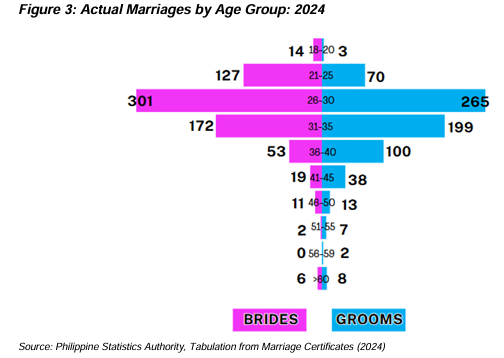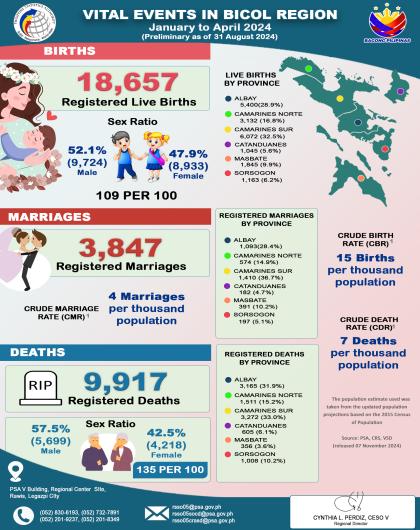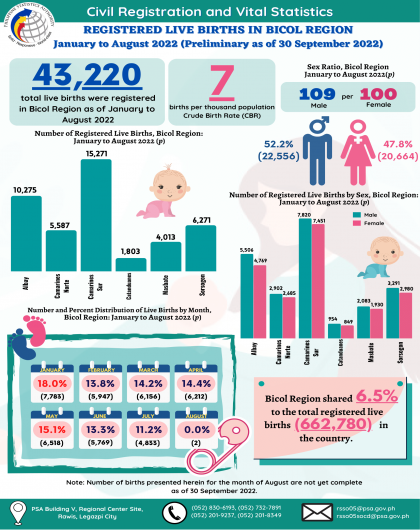More Men Than Women in Catanduanes
As of May 1, 2020, Catanduanes recorded a total population of 271,879 individuals. Of this, 132,709 are female, and 139,170 are male, resulting in a sex ratio of 100:105 - indicating a slightly higher number of males than females in the province.

Demographic Breakdown: Age and Sex Distribution
The population distribution by age group highlights the following trends:
• Children under 5 years old: There were 14,124 females and 15,278 males, totaling 29,402 individuals. Females made up 48% while males accounted for 52% of this age group. The distribution suggests a slightly higher number of male births.
• School-age population (5-24 years old): This age group comprised 54,994 females and 59,692 males, totaling 114,686 individuals. The sex ratio remained consistent, with 48% females and 52% males.
• Voting population (18 years and older): Among the 162,975 individuals in this category 80,404 were females (49%) and 82,571 were males (51%).
• Senior citizens (60 years and older): This group totaled 26,678 individuals, with 15,015 females (56%) and 11,663 males (44%). The higher percentage of females indicates a greater number of women in the older age brackets.
The Age-Sex Pyramid further illustrates these trends, showing a generally youthful population structure, with more males in younger age groups and a higher proportion of females in older age brackets.

Catandunganons Achieve 97% Literacy
Literacy among the household population aged 5 years and over in Catanduanes remains high. Out of 241,448 individuals in this age group, 234,315 are considered literate, achieving a literacy rate of 97.3% for females and 96.8% for males.
The youngest age group (5-9 years old) has the lowest literacy rate at 83.6%, with 25,604 literate individuals out of 30,616. The 10-14 and 15-19 age groups reported the highest literacy rate of 99.5%, indicating that most individuals in these age brackets have acquired basic literacy skills. The working-age groups (20-59 years old) maintain consistently high literacy rates between 98.8% and 99.2%, while senior citizens (65 years and older) exhibit a literacy rate of 97.3%.


Men Lead the Workforce
In 2020, Catanduanes had 181,276 total population aged 15 years and over, of which about three in every five persons (55.5 percent) were engaged in a gainful activity during the 12 months preceding the census. The data reveals a significant gender disparity in employment, with males comprising nearly two-thirds of the employed population (67,154 males vs. 33,404 females). Most gainfully employed individuals worked within their home province and municipality (81,163), with a smaller portion commuting to different municipalities within Catanduanes (9,807). A limited number sought employment outside the province (4,215), and even fewer worked abroad (2,702), indicating that the majority of the workforce remains locally based. The higher foreign employment rate among females (1,752) compared to males (951) suggests that women might be more likely to seek work opportunities internationally.


3,559 Babies Born in Catanduanes in 2024
In 2024, Catanduanes recorded a total of 3,559 live births, with 1,744 female babies (49%) and 1,815 male babies (51%) resulting in a sex ratio at birth of 100 female babies per 104 male babies.
Among municipalities, Virac had the highest number of live births (977), accounting for 27% of the province’s total births. This is followed by San Andres (580) and Caramoran (396). These municipalities, being among the most populous, contribute significantly to the province’s birth rates.Conversely, Panganiban (117) and Gigmoto (129) recorded the lowest number of births, reflecting their smaller populations.
In most municipalities, male births slightly outnumbered female births, except in Bato (136 females vs. 122 males) and Bagamanoc (71 females vs. 57 males), where female births exceeded male births.

129 Men Died for Every 100 Women in Catanduanes
A total of 1,803 deaths were registered in 2024 with 788 females and 1,015 males, translating to the overall sex ratio of 100:129, indicating a slightly higher male mortality.
The highest number of deaths was recorded in Virac (508), San Andres (273), and Caramoran (165), while Panganiban (49), Gigmoto (58), and Bagamanoc (63) had the fewest. Males accounted for more deaths in most municipalities, particularly in San Andres and Virac.

705 Couples Married in Catanduanes in 2024
In 2024, a total of 705 marriages were recorded in Catanduanes. The youngest recorded bride was 18 years old, while the youngest groom was 19 years old. On the other end of the spectrum, the oldest bride was 75 years old, and the oldest groom was 74 years old.
Additionally, there were two Filipino grooms married to non-Filipino brides, and 12 Filipino brides entered into marriages with non-Filipino grooms.
The most common marrying age group was 26-30 years old, accounting for 301 brides and 265 grooms.


CONCEPTS AND DEFINITIONS
2020 Census of Population and Housing was a nationwide government undertaking that involved the collection, compilation, evaluation, analysis, publication, and dissemination of data on population count, demographic and socio-economic characteristics of the population, housing characteristics, household characteristics, and barangay characteristics in each barangay, city/municipality, province, and region in the country.
Household population comprises of persons who belong to a household.
Live Birth is a complete expulsion or extraction from its mother of a product of conception, irrespective of the duration of the pregnancy, which after such separation, breathes or shows any other evidence of life, such as beating of the heart, pulsation of the umbilical cord, or definite movement of voluntary muscles, whether or not the umbilical cord has been cut or the placenta is attached; each product of such a birth is considered liveborn.
Death refers to the permanent disappearance of all evidence of life at any time after livebirth has taken place.
Marriage is a special contract of permanent union between a man and a woman entered into in accordance with law for the establishment of conjugal and family life.















